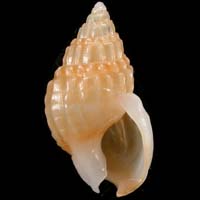|
< Previous family introduction |
|
|||||
 |
Family
Nassariidae
Dog whelks
|
|||||
|
The Nassariidae is a group of small to very small species, generally less that 20 mm in length, common to abundant in intertidal sandy and muddy habitats, but with some species occurring subtidally and a few extending to abyssal depths. They occur in tropical, temperate and cold waters, but are most common in the tropics. The animals are relatively large in comparison to shell size, and are generally agile and active. Around Sydney the two common species Nassarius jonasii and Nassarius burchardi are prominent components of the intertidal fauna, and can be commonly seen crawling on sand flats at low tide in bays and estuaries. Numbers can be attracted by throwing dead fish or mollusc into a sandflat pool. Nassariids are generally carrion feeders, and are equipped with a very long proboscis for reaching food in cracks or crevices and have a good chemical sensory mechanism. There are about 18 species reported from NSW, falling into several distributional groups. A few species found only in the north of the state belong to the large group of species which occurs in the tropical Indo-West Pacific faunal region, and are at the southern limit of their distribution. Another group of species is restricted to Australia, and several are restricted to NSW. About half of the local species occur intertidally or in the shallow subtidal, so are frequently found washed up on beaches, but the rest occur in deeper water, one species being recorded down to 2100 m. This subfamily is one of the groups that are relatively well known taxonomically, due to the work of W.O. Cernohorsky. Even so, there are some unresolved issues relating to some of the lesser known deep water species.
Family references Cernohorsky, W.O. 1972. Indo-Pacific Nassariidae (Mollusca: Gastropoda). Records of the Auckland Institute and Museum 9:125-194. Cernohorsky, W.O. 1981. Revision of the Australian and New Zealand tertiary and recent species of the family Nassariidae (Mollusca: Gastropoda). Records of the Auckland Institute and Museum 18:137-192. Cernohorsky, W.O. 1984. Systematics of the family Nassariidae (Mollusca: Gastropoda). Bulletin of the Auckland Institute and Museum No. 14. Identification Notes: The columellar callus and thickening of the outer lip are characters frequently used in this subfamily to identify species. Their development depends on shell maturity, thickening and expanding as the shell matures, but is completely absent in juvenile shells. Denticles on the inside of the outer lip are a variable character in many species of this subfamily, and may vary from absent to strong in the adults of some species. All species of the family recorded from NSW are covered. The following are species of tropical Indo-West Pacific distribution that reach into northern NSW. Nassarius albescens (Dunker, 1846)
Nassarius babylonicus (Watson, 1882)
Nassarius dorsatus (Roding, 1798)
Nassarius gaudiosus (Hinds, 1844)
Nassarius granifer (Kiener, 1834)
Nassarius splendidulus (Dunker, 1846)
|